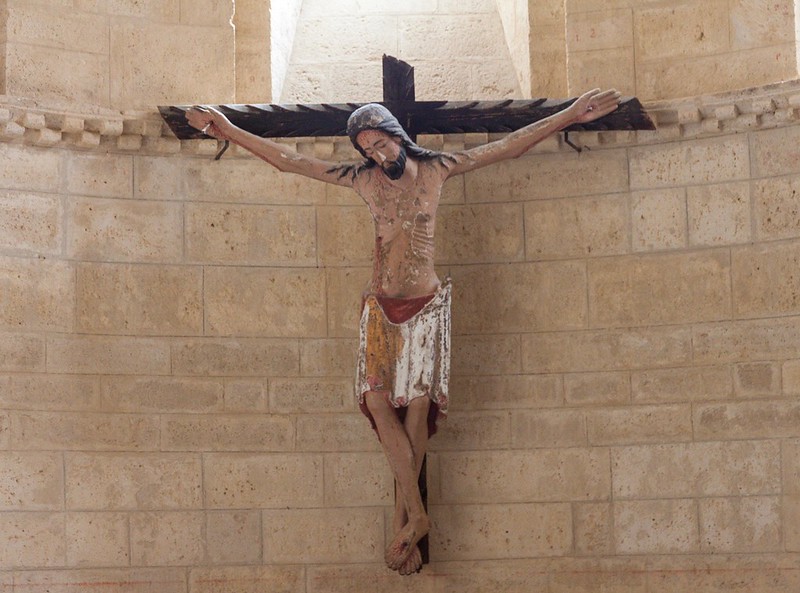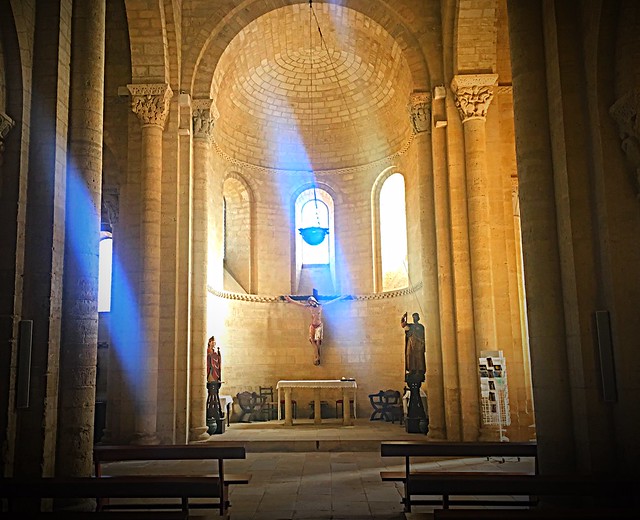What Does This Mean? (Five Hundred Miles of Crucifixes)

What Does This Mean? (Five Hundred Miles of Crucifixes)
Brian Zahnd
Six months ago Peri and I walked five hundred miles across Spain on the Camino de Santiago. It was quite simply the most wonderful, most spiritual, most healing thing we’ve ever done. The Camino changed both of us. This morning as I prayed I thanked God in tears for the gift of the Camino. Until today I’ve not written about it, mostly because I’m still absorbing it. But Holy Week seems like the right time to share one aspect of my experience.
We began the Camino on September 14, 2016 ( Holy Cross Day). After a long trek across the Pyrenees mountains from St.-Jean-Pied-de-Port, France we arrived in Roncesvalles, Spain. In Roncesvalles I spent some time alone in a thirteenth century chapel gazing on a medieval crucifix. While sitting in this dimly lit sanctuary the Holy Spirit seemed to give me four instructions for my five hundred mile walk:
1. Enter every church you can.
2. Pay close attention to every crucifix you see.
3. Ask this question: What does this mean?
4. Don’t be too quick to give an answer.
And that’s what I did for forty days. Asking of every crucifix, what does this mean, and resisting the temptation to give a quick answer. If we’re too quick to give an answer we domesticate the crucifixion. This is the bane of tidy atonement theories. Instead of the crucifixion remaining a compelling story, it’s turned into a sterile formula. The cross is shrunk to one of the four spiritual laws or one of the three steps to salvation. This is the crucifixion sanitized — the cross made palatable and devoid of scandal.
So I gave no quick answer to the question. But now, six months later, I’m ready to suggest some responses to the question posed by five hundred miles of crucifixes.
First of all, the crucifixion is scandalous. It’s the greatest of all scandals. The crucifixion of Jesus is easily the most depicted event in human history — but what is being depicted? At an objective level it’s the torture and murder of an innocent man. That’s what it is. And that’s a scandal! The crucifixion is the damning indictment of the world as it has been arranged. When the Son of God entered our world, our systems of violent empire and sacrificial religion nailed him to a tree. This is the moment when the principalities and powers that run the world were put to shame and their claims of being wise and just were shown to be nothing but an empty sham. (See Colossians 2:15) Every crucifix reminds us that systems of civilization built around an axis of power enforced by violence are not to be trusted.
I’m not sure why Protestants abandoned crucifixes for empty crosses, but I think it was a mistake. (I know Protestants will often argue, “Jesus didn’t remain on the cross.” Well, Jesus didn’t remain in the manger either, but Protestants don’t raise that as an objection to nativity scenes.) A depicted crucifixion replaced with an abstract symbol seems to indicate a move to reduce the crucifixion to a kind of mathematical sign, a theological equation. Once we do that, we can easily lose sight of the fact that on Good Friday we are confronted with the horror of a state-sponsored, religiously endorsed execution of an innocent man. The crucifixion of Jesus forever calls into question any assumption that we are capable of employing violence in a wise and just manner.
As I spent time everyday meditating on depictions of Christ crucified, I began to realize that I was seeing a divine revelation regarding God and violence. That God entered into history as a crucified victim and not as a crucifying punisher reveals the true relationship between God and violence. On Good Friday we discover a God who would rather die than kill his enemies. The cross is not what God inflicts upon Christ in order to forgive, the cross is what God in Christ endures as he forgives.
Then there’s the crucifix as the supreme depiction of unspeakable pain.
Like nearly every pilgrim on the Camino I had to deal with blisters. For two weeks during the middle of our Camino my feet were extremely painful. (Here’s a picture. Viewer discretion advised!) When my feet were hurting and I walked into a church to meditate on a crucifix I was often drawn to the pierced feet of Christ. Eventually I came to see my painful feet as a gift. My pain alerted me to the truth that Christ entered our world to share our sorrows and bear our pain. On October 4th I wrote this in my journal:
I’ve believed all along that God wants me to walk this Camino; and if I’m supposed to walk two hundred miles or more in pain, so be it. Jesus was a man of sorrows, acquainted with pain. So as I walk with pain I try to remember those I know who live with pain — physical, emotional, mental, and spiritual pain. And I pray for them. “By his wounds we are healed.” (1 Peter 2:24) Here is a mystery: When we bring our wounds to the wounds of Christ, it does not increase woundedness, but tends toward healing.
The day after I wrote these words my feet began to heal. And by the time we reached Santiago, I was entirely pain-free. But the gift of pain had taught me a profound lesson. Thank you, Jesus.
The final observation from five hundred miles of crucifixes is that most of them were artistically beautiful. Of course, this is a very strange thing. On a purely objective level there is nothing beautiful about the sight of man being tortured to death. And yet beauty is present in the crucifixion of Jesus, and artists render us a great service by calling our attention to it. Shining through the grotesque ugliness of human torture and murder is the beauty of divine love and forgiveness.
“Father, forgive them, for they know not what they do.” (Luke 23:34)
This is the beauty that saves the world.
On Good Friday through our systems of violent power and sacrificial religion we sinned our sins into Jesus. Jesus absorbed our sins and recycled them into love and forgiveness. The cross is as ugly as human sin and as beautiful as divine love — but in the end love and beauty win. As Hans Urs von Balthasar said, “Being disguised under the disfigurement of an ugly crucifixion and death, Christ upon the cross is paradoxically the clearest revelation of who God is.”
As we approach Good Friday I invite you to meditate upon how the cross…
- Unveils the ugliness of human violence
- Reveals the beauty of God’s forgiving love.
- Reminds us of how God in Christ shares our pain.
- Shows us the beauty of Christ that saves the world.
Amen.
BZ
(The photo is of the crucifix in the thousand-year-old Church of San Martin in Frómista. The village of Frómista was where we took our only day off. Due to my blisters and Peri having a severe cold we had to. As a result of our rest day I was able to visit the Church of San Martin twice and spent considerable time meditating on the crucifix. We also met an angel in Frómista…but that’s Peri’s story to tell.)

Church of San Martin, Frómista, Spain